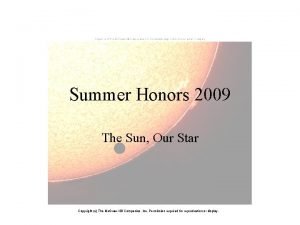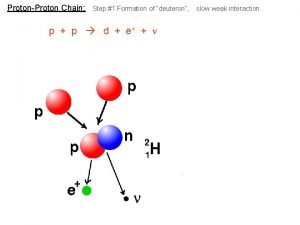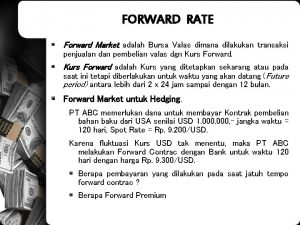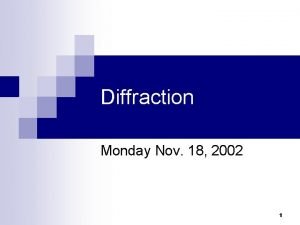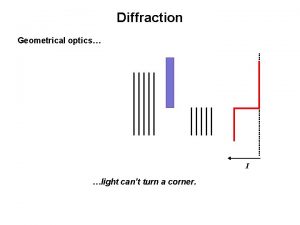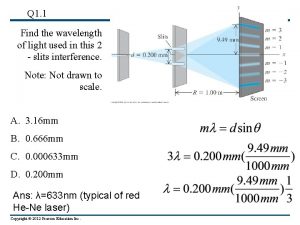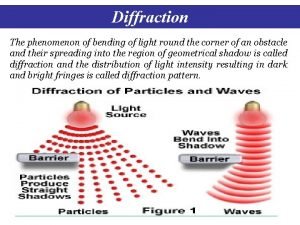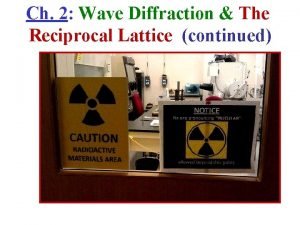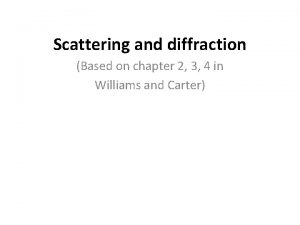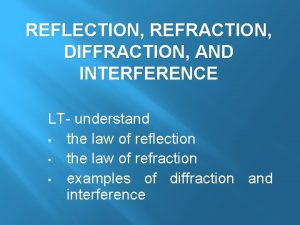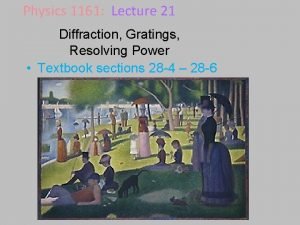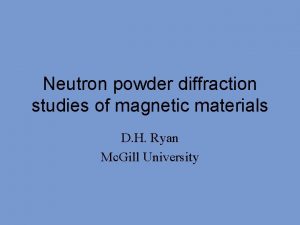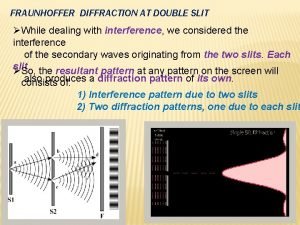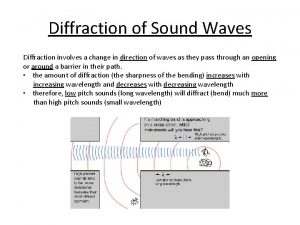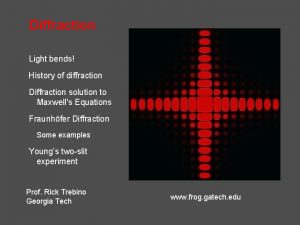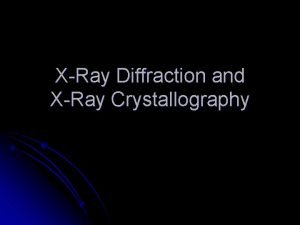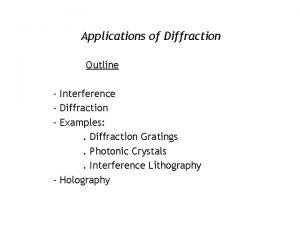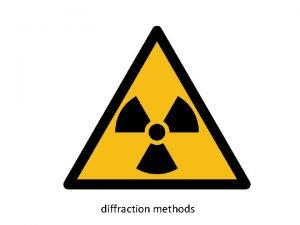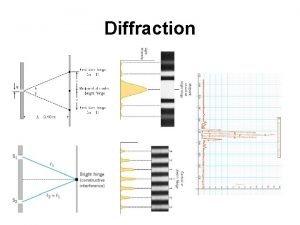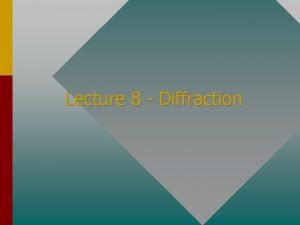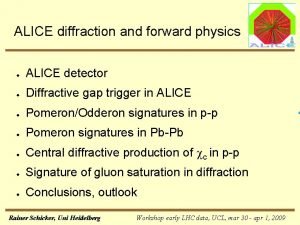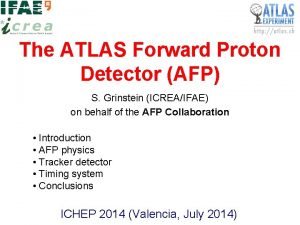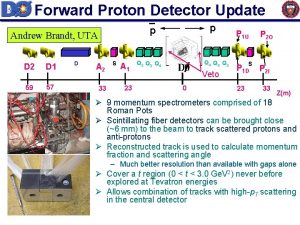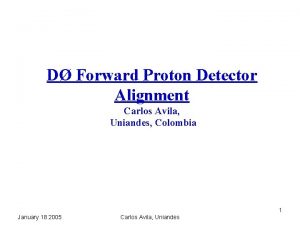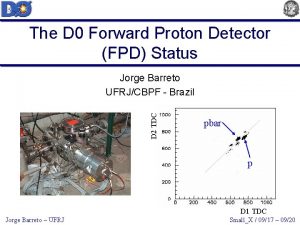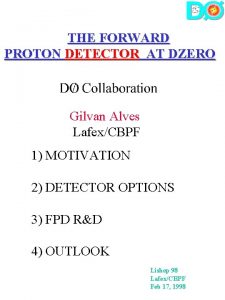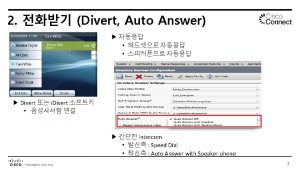Diffraction and the Forward Proton Detector at D





















- Slides: 21

Diffraction and the Forward Proton Detector at DØ Michael Strang Physics 5391, 22/July/02 Michael Strang

What is Diffraction? Ø Diffraction encompasses events in which one or both incoming particles undergo diffractive dissociation with any surviving particle having a small angle with respect to the beam axis. Ø Basically diffraction in high energy hadron physics encompasses those phenomena in which no quantum number is exchanged between interacting particles – Diffracted particles have same quantum numbers as incident particles or in other words quanta of the vacuum are exchanged Ø Exchanging quanta of the vacuum is synonymous with the exchanging of a Pomeron (P) – Named after Russian physicist I. Y. Pomeranchuk – Virtual particle carries no charge, isospin, baryon number or color – Couples through internal structure Ø Can occur in p-pbar and e-p collisions Physics 5391, 22/July/02 Michael Strang

Types of Diffraction Ø Broken into two basic types – Soft diffraction • Modeled by Regge theory (predates QCD) – Analysis of poles in the complex angular momentum plane giving rise to trajectories that describe particle exchange • Non-perturbative QCD regime – Hard diffraction • Modeled by various theories (some building upon Regge Theory) • Tries to exploit perturbative QCD regime • Allows probing of structure of Pomeron Ø Seen in calorimeter through rapidity gaps (regions of the detector with no particles above threshold) and/or tagging the intact final particle Ø Diffractive events can account for ~40% of the inclusive cross section of a process Physics 5391, 22/July/02 Michael Strang

Elastic Scattering Ø The particles after diffraction are the same as the incident particles Ø The cross section can be written as: Ø This has the same form as light diffracting from a small absorbing disk, hence the name diffractive phenomena A* A P B B* B* f A* h Physics 5391, 22/July/02 Michael Strang

Soft Single Diffraction Ø One particle continues intact while the other becomes excited and breaks apart (diffractive dissociation) A* A P X B f h Physics 5391, 22/July/02 A* Michael Strang

Hard Single Diffraction Ø One particle continues intact while the other undergoes inelastic scattering with the Pomeron and breaks apart into a soft underlying event as well as some hard objects (jets, W/Z, J/y or massive quarks) A X P J 2 X J 1 X B f h Physics 5391, 22/July/02 A* Michael Strang

Double Diffraction (Color Singlet Exchange) Ø Both incoming particles undergo diffractive dissociation (one dissociates by emitting a hard color singlet that then undergoes an inelastic collision with the other particle). Ø The diffraction can be hard or soft. X A X CS J 2 X J 1 X B f h Physics 5391, 22/July/02 Michael Strang

Hard Double Pomeron Ø Both particles continue intact while hard objects still appear in the detector (Pomeron undergoing inelastic scattering with another Pomeron) A* A P X J 2 X P J 1 X B B* B* f h Physics 5391, 22/July/02 A* Michael Strang

Diffractive Variables Ø x = 1 – p. A* / p. A – the momentum fraction of hadron A taken by the Pomeron (diffraction dominates for x< 0. 05) Ø t = (p. A – p. A* )2 = – 2 k 2(1 – cosq) – Minus the standard momentum transfer squared where k is CM momentum and q is the CM scattering angle Ø MX (diffractive mass) for the resultant system is given by – s is the total CM energy squared Physics 5391, 22/July/02 Michael Strang

Ingelman-Schlein Model Ø Attempt to blend Regge theory with perturbative QCD Ø Factorize the cross section Ø Flux factor (structure function for Pomeron content in A) given by a global fit found by Donnachie and Landshoff and remaining part of cross section can be factorized leaving as the only unknown the structure function of the Pomeron (proposed as two quarks or two gluons of flavor similar to proton) Ø Hard scattering probes structure of Pomeron (jet production --> gluon structure, W production --> quark structure) Physics 5391, 22/July/02 Michael Strang

BFKL Theory Ø Proposes a more involved gluon structure of the Pomeron Ø Add perturbative corrections to two reggeized gluons to form a gluon ladder Ø Use leading logarithmic approximation as the resummation scheme using the BFKL equation Ø Resummed amplitude has a cut in the complex angular momentum plane called the BFKL Pomeron Ø Causes a different jet topology than I-S Physics 5391, 22/July/02 Michael Strang

Soft Color Evaporation Ø Account for rapidity gaps without need of a Pomeron Ø Allow soft color interactions to change the hadronization process such that color lines are canceled and rapidity gaps appear (non -perturbative, color topology of event changes) f h Ø Look at difference in gap production of gluon processes vs. quark processes to find evidence Physics 5391, 22/July/02 Michael Strang

Bellows Forward Proton Detector Roman Pot p p Detector P 1 U D 2 D 1 59 57 D S A 2 A 1 33 23 Q 4 Q 3 Q 2 Q 3 Q 4 Veto 0 P 2 O S P 1 D P 2 I 23 33 Z(m) Series of 18 Roman Pots forms 9 independent momentum spectrometers allowing measurement of proton momentum and angle. p. Beam p. F P 1 Dipole Spectrometer ( p ) x > xmin 8 Quadrupole Spectrometers (p or p, up or down, left or right) t > tmin Physics 5391, 22/July/02 Michael Strang

Detector Needs Ø Position resolution of 100µm – Beam dispersion and uncertainty in beam position make better resolution unnecessary Ø Efficiency close to 100% Ø Modest Radiation Hardness - Operates at 8 s from beam axis, 0. 03 MRad yearly dose expected Ø High Rate capability - Active at every beam crossing Ø Low background rate - Insensitive to particles showering along beam pipe Ø Small dead area close to the beam - Protons are scattered at very low angles, acceptance is very dependent on position relative to beam Ø Scintillating Fiber detector spliced with waveguide meets these needs Physics 5391, 22/July/02 Michael Strang

Detector Layout 6 planes per pot 2 planes with same orientation offset by 2/3 Fibers are separated by 1/3 in each plane 20 channels U/V, 16 for X Sci. Trigger in each pot Read out by MAPMTs Physics 5391, 22/July/02 Michael Strang

Simulated Diffractive Events Hard Diffractive Candidate Hard Double Pomeron Candidate Physics 5391, 22/July/02 Michael Strang

Backgrounds X S. Drozhdin A. Brandt Needs Data Early time hits t=0 Reject Halo fakes using trigger scint. timing info Multiple Interactions pile-up p(pbar) S. D. + Dijet 1) Using FPD tracks at L 1; cut on < 0. 01 Low dominates pile-up 0 M. Martens Resolution Physics 5391, 22/July/02 2) Cut at T on L. M. M. I. S. I. TL TH L. M. algo C. Miao FPD W. Carvalho TL TH Michael Strang

Current Status Ø FPD appears to be working Ø Collecting data independent of rest of DØ (except for Luminosity Monitor signals) Ø Studying different spectrometers Ø Using data to understand the detectors – alignment, efficiencies, resolution, … Ø Working towards optimizing operating positions and parameters Ø Working on integration into rest of DØ Physics 5391, 22/July/02 Michael Strang

Future Measurements Using FPD Ø Observation of hard diffractive processes through tagging Ø Measure cross sections Dominated by angular dispersion 15% error for (reduced with unsmearing) Ø Measure kinematical variables with sensitivity to pomeron structure ( h, ET, …) Use Monte Carlo to compare to different pomeron structures and derive pomeron structure Ø Combine different processes to extract quark and gluon content. Physics 5391, 22/July/02 Michael Strang

FPD Measurements (1 fb-1) Hard gg Et > 15 Ge. V 0<|t|<3 Ge. V 2 Hard qq Soft (1 -x)5 Et > 15 Ge. V 10, 000 events Hard x(1 -x) Physics 5391, 22/July/02 Michael Strang

gio n Re ole Qu ad rup Dip o le R egi on FPD Measurements (1 fb-1) (Arbitrary Scale) Physics 5391, 22/July/02 Michael Strang
 Proton proton chain
Proton proton chain Fission reaction
Fission reaction Proton proton chain
Proton proton chain Contoh forward market
Contoh forward market Forward market adalah
Forward market adalah Fresnel and fraunhofer diffraction
Fresnel and fraunhofer diffraction Diffraction by circular aperature
Diffraction by circular aperature Diffraction pattern
Diffraction pattern Blue relfection ray
Blue relfection ray Diffraction through single slits derivation
Diffraction through single slits derivation Difference between fresnel and fraunhofer diffraction
Difference between fresnel and fraunhofer diffraction Diffraction condition in reciprocal lattice
Diffraction condition in reciprocal lattice Diffraction and scattering
Diffraction and scattering Path length difference
Path length difference Reflection refraction diffraction interference
Reflection refraction diffraction interference Reflection refraction diffraction
Reflection refraction diffraction Multiple slits diffraction
Multiple slits diffraction Magnets for neutron diffraction
Magnets for neutron diffraction Absent spectra in diffraction grating
Absent spectra in diffraction grating What is dispersive power of plane transmission grating?
What is dispersive power of plane transmission grating? Sound diffraction
Sound diffraction Diffraction of light
Diffraction of light
